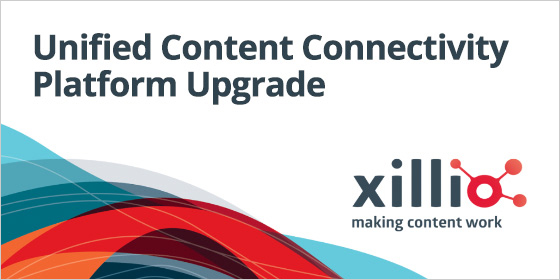Xillio CTO Discusses Content Connectivity Platform Upgrade
By Natalie Evans
September 19, 2018
API, content connectivity, content management, content services, ECM, Enterprise, Enterprise Content Management, Integration, SDL, Xillio
Today, organizations struggle with the large amounts of content that they produce and process on a daily basis. Spending a large portion of their time on searching, processing and creating content, which is created and stored in different types of systems, such as ECM, DAM, WCM,  archive, CRM, file share and many more. Xillio, a specialist in content migration and integrations, recently released a major upgrade to it Xillio API Platform to combat this issue. The upgrade will allow Xillio to expand its reaches with its new features in it’s API along with its upgrades to its unified Content Connectivity platform. Xillio’s goal is to deliver a unified and uniform approach to making business content stored in any content repository or file share whether it be cloud, on-premise or legacy systems, allowing for easy accessibility to all applications.
archive, CRM, file share and many more. Xillio, a specialist in content migration and integrations, recently released a major upgrade to it Xillio API Platform to combat this issue. The upgrade will allow Xillio to expand its reaches with its new features in it’s API along with its upgrades to its unified Content Connectivity platform. Xillio’s goal is to deliver a unified and uniform approach to making business content stored in any content repository or file share whether it be cloud, on-premise or legacy systems, allowing for easy accessibility to all applications.
I was able to connect with Xillio's CTO, Jeroen Huinink for an exclusive interview to discuss Xillio's major upgrades and key features to its Unified Content Connectivity platform and his thoughts on what companies should consider when undertaking a content integration plan.
There was a comment made that the new version of “Xillio API I is ideal for the translation industry, business process management and Long-Term Storage (LTS) applications” could you please explain why?
“The requirement that these use case share is that they each need to access content, and the associated metadata, from many different sources and often many different sources at once. The Xillio API makes it very easy for developers to build integrations with all these systems: they don’t need to worry about the details of each individual system. Access to content an d metadata is unified by Xillio. With the Xillio API, they only need to build one integration to access all those systems. One call does it all.”
d metadata is unified by Xillio. With the Xillio API, they only need to build one integration to access all those systems. One call does it all.”
What makes Xillio’s API platform more desirable than others? Do you think that this upgrade is a significant one that will change the way we integrate content?
“Content integration is primarily done by building an integration into an individual system. If there is a need to integrate content from three sources, developers need to build three integrations. With Xillio there is no longer a need to build individual integrations. The API unifies access to all types of content from all repositories. Because the API leverages industry standards and best practices, it is very easy for developers to use regardless of the platform that they are working in. Building integrations with Xillio becomes an easy task, instead of a tedious painstaking endeavor. This makes the Xillio API a game changer, greatly accelerating the availability of integrations and capabilities to end-users.”
How will this upgrade impact your users – would you like to elaborate on the new features?
“The Xillio API is designed for the cloud. Our cloud users get new features automatically as soon as they are available. On-premise users can easily upgrade to the latest version. Developers building integrations are the primary users of the API: they leverage the Xillio API to provide access to content for the users of their applications. The new features are added in a backwards compatible way, meaning that the current integrations continue to work and new capabilities can be added by developers when needed.”
Could you tell me what companies should consider when undertaking a content integration plan?
“We don’t think that something as a content integration plan needs to exist. Business users have genuine requirements to get better and faster access to content from within their primary application, whether they work in bespoke applications or applications from third-party vendors. In addition, organizations need to better understand and control the information that they have stored in their content silos. Fulfilling these requirements one at a time is what drives content integration. The Xillio API is the most efficient way for developers to add those capabilities.”
The Xillio API content connectivity platform allows developers to build integrations from their applications to any popular content repository. Building this type of integration takes a lot of resources. Xillio takes care of all the content system connectivity behind the scenes, no matter how many different systems they want to access.
New Key Features
-
Query feature
Now you can execute a query to search for documents or objects in a repository and retrieve all entities and metadata matching the query parameters. For example, you could retrieve all objects that have changed since a given date. The query is defined once and can be used over and over again. Until now, the application had to implement a query function. With this new release, you can leverage the querying capabilities of the underlying content system. Use cases range from finding all the objects that have not been committed to Long Term Storage (LTS), to finding all content that was changed and must be resubmitted for translation.
-
Retrieve custom metadata
The Xillio API now supports uniform access to custom metadata. This feature is essential for business process management or workflow management use cases, where workflow status is stored as custom metadata. This custom metadata can now be accessed in a unified structure, so developers no longer need to be aware of the details of the repositories with which they need to integrate.
-
Retrieve version information
Some repositories automatically track the change history of an object by saving multiple versions. This new feature offers a uniform way to retrieve information about the available versions and learn about a specific version’s metadata and content.
-
Retrieve translation information
The Xillio API now offers uniform access to all the different translations of the objects and pages that are available within a certain content repository. This enables retrieving information about multiple translations within applications.
-
Content scripts feature for WCM
This feature is especially valuable for users working with multiple web content management (WCM) systems. Each system has its own way to store pages and content. There is a demand for uniform access to this page content across multiple systems. You can now write content scripts to change the format of the retrieved content. This makes it possible to normalize the output from different WCM systems into one unified format.
See How it Works
“Our vision is to enable application developers with a uniform approach to content connectivity through our API platform, and we are constantly adding new features to the Xillio API and our public cloud to meet this growing demand,” said Huinink.
“It is now possible for any developer to write one integration and access content from many different repositories. As a result, it is no longer necessary to learn or understand multiple systems nor to write boilerplate code – we handle that for them.” he added.
Ending Notes
As mentioned, Xillio’s new version of its API is ideal for the translation industry, business process management, and Long-Term Storage applications. This is no surprise since September last year Xillio made an OEM agreement with SDL. As part of this agreement, SDL integrated Xillio software into its translation technology product line, starting with SDL Managed Translation.
Developing this type of software is very time consuming and so expensive and why reinvent it when you can have someone else create a first-class API that does it all for you? They handle the connector upgrades so you don’t have to. The Xillio API supports the most widely known content repositories with its connectors.
Currently, there are connectors to SharePoint, Office365, Adobe Experience Manager, Alfresco, GitHub, Zendesk, Drupal, Elastic, Hippo, Wordpress, Documentum, Box, Umbraco, Liferay, Dropbox, and Egnyte just to name a few. This list is continuously expanding with new connectors.

Natalie Evans
Natalie Evans has over 16-years in the tech industry and currently works as the event coordinator and tech reporter for CMS-Connected, keeping up-to-date on what's happening in and around the Content Management industry.